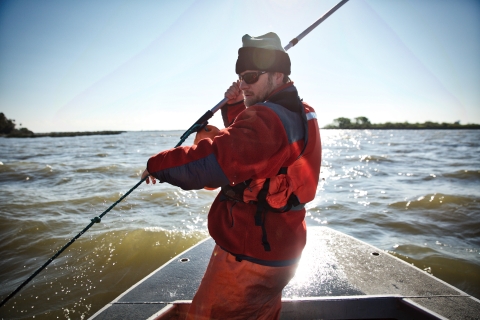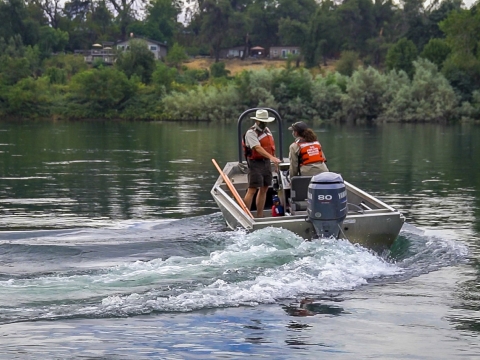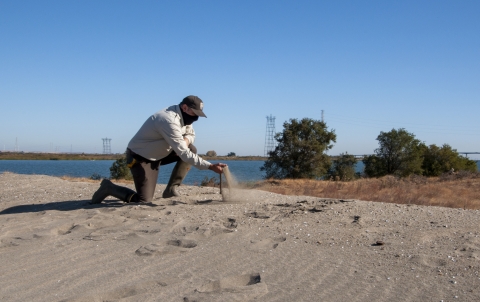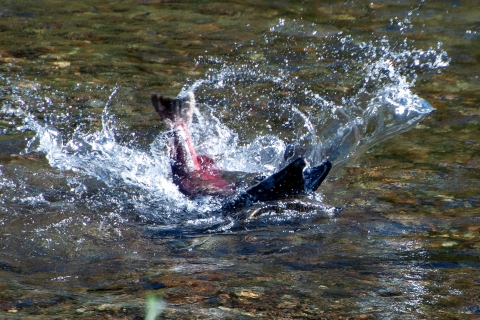Projects and Research
Delta Smelt Supplementation
Bay-Delta and our partners are working on a plan to begin releasing hatchery-raised Delta smelt in 2024 to bolster the threatened fish's wild population.
Our genetics-management and species-supplementation experts are collaborating with other federal and state agencies, the University of California, Davis, and other stakeholders on research projects to guide the supplementation plan.
These projects include developing a spawning strategy that will achieve genetic-management objectives, and developing genomics-based markers that will enable us to monitor smelt in the wild and estimate the genetic effects of supplementation.
Learn more on the Delta Smelt Supplementation page.
Delta Smelt Statistical Models and Research
Statisticians and biologists in the Bay-Delta and Lodi Fish and Wildlife offices have created a Delta Smelt Life-Cycle Model and a Delta Smelt Individual-Based Model to assess and predict the effects of water resource-management actions on the Delta smelt population. The team worked for years to create the models, which help scientists follow trends in fish abundance, reproduction and mortality. Learn more on the Delta Smelt Statistical Models page.
In addition, our teamuses monitoring data to estimate how many fish are in the Delta and where they are located. We also help develop new fish survey designs and apply the data to better understand habitat use, movement and abundance changes, primarily related to the Enhanced Delta Smelt Monitoring program run by the Lodi Fish and Wildlife Office.
Bay-Delta's research on Delta smelt has produced many papers published in peer-reviewed journals, which can be accessed on the Delta Smelt Researchpage.
Smelt Monitoring Team
The Bay-Delta office participates in the Smelt Monitoring Team, which provides biological and technical recommendations on Delta smelt and longfin smelt issues associated with the Central Valley Project and State Water Project. The group uses data from smelt monitoring surveys and other information sources to develop recommendations that reduce the risk of trapping Delta smelt in water-pumping facilities. The group also includes experts from the Bureau of Reclamation, State Water Board, National Marine Fisheries Service, California Department of Water Resources and California Department of Fish and Wildlife.
Fish Restoration Program
We are partnering with several state and federal agencies, water districts and private organizations to restore thousands of acres of tidal wetlands for the benefit of Delta smelt, longfin smelt and salmonids. The Bureau of Reclamation and the California Department of Water Resources proposed this restoration as a result of the effects of the coordinated long-term operation of the Central Valley Project and State Water Project.
The 460-acre Tule Red habitat restoration and 1,600-acre Lower Yolo Ranch Tidal Habitat Restoration have both been completed under this program. The Tule Red project was designed to bolster the food web for Delta smelt. It built channels to convey water across the marsh plain, and it breached a levee, which enabled tidal exchange and created ponds where zooplankton could grow. The Lower Yolo Ranch project restored former cattle pasture to provide new sources of food and shelter for Delta smelt, salmon and other native fishes.
Interagency Ecological Program
The Interagency Ecological Program is a collaboration of six federal agencies and three state of California departments, which have been conducting ecological investigations together since the 1970s. The IEP leads monitoring, research, modeling and synthesis efforts that aid the management of the Bay-Delta ecosystem and the water that flows through it.
Collaborative Science and Adaptive Management Program
CSAMP is a collaboration of federal and state natural resource agencies, environmental groups and public water agencies, which was established in 2013. The program focuses its efforts on science and management issues related to the Central Valley Project and State Water Project, species of concern in the Delta and upriver, and actions to improve the resilience of Delta smelt and salmonids. Our experts contribute to CSAMP as well as its Collaborative Adaptive Management Team, Delta Smelt Scoping Team and Delta Smelt Structural Decision-Making Team.
Delta Research Station
The Service and the California Department of Water Resources have proposed to build the Delta Research Station, a combination of two collaborative facilities in Rio Vista: an estuarine research center and a fish technology center.
The Station would consolidate a number of new and existing activities, provide space for research into smelt and other native species, and produce significant numbers of Delta smelt for supplementation efforts.
Antioch Dunes Restoration
Bay-Delta is overseeing the restoration of Antioch Dunes National Wildlife Refuge, including the addition of sand through a partnership with the Port of Stockton. The 55-acre site in urban Antioch is the first national refuge established to protect insects and plants: the Lange’s metalmark butterfly, Antioch Dunes evening primrose and Contra Costa wallflower.
The two plants' outlook has improved since the Port began delivering sand in 2013. The butterfly has not responded as strongly to the dune restoration or an earlier breeding program, but experts are planning the next phase of recovery.






